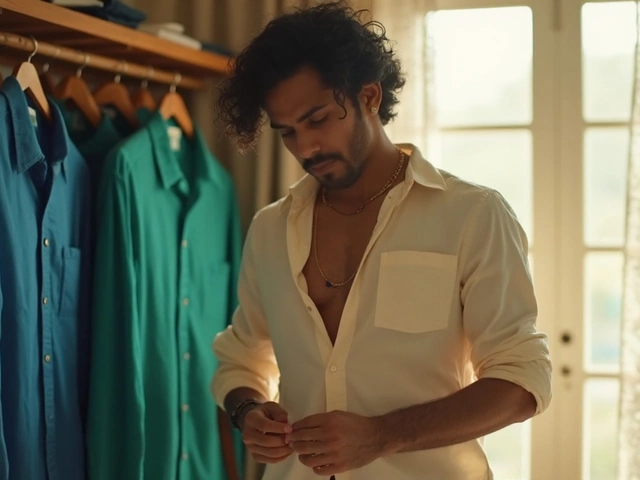When it comes to body modifications, a nose piercing can be an alluring option. It's a small change with a big impact—both in terms of style and personal expression. However, not everyone should rush into getting a nose piercing without thinking it through carefully.
Several factors might make this popular accessory less than ideal for some people. Whether it's due to health concerns, lifestyle clashes, or allergic reactions, each person's situation is unique when it comes to this piercing decision. It's important to reflect and examine the reasons why a nose piercing might not be advisable for you.
From the possibility of job restrictions to age considerations, the reality is that this decision requires some thought. Additionally, if you decide it's the right time for a piercing, choosing the perfect nose pin design is another exciting yet crucial step.
- Understanding Health Concerns
- Potential Allergic Reactions
- Employment and Lifestyle Considerations
- Age and Maturity Requirements
- Choosing the Right Nose Pin Design
Understanding Health Concerns
When considering a nose piercing, it's crucial to evaluate potential health issues that might affect the decision. First and foremost, skin sensitivity and propensity for infections play a vital role. If you're someone with a history of allergic reactions, particularly with metal jewelry, determining the material of the piercing is crucial. Nickel, commonly found in metals, causes reactions in sensitive individuals. Opting for hypoallergenic options like titanium or gold can minimize such risks.
An underlying health condition, such as diabetes, can complicate the healing process. With diabetes, especially Type 1 and Type 2, the body's ability to heal is compromised, making a simple piercing potentially dangerous. A slow healing rate can open the door to infections—a situation no one wants to experience. Furthermore, autoimmune disorders or conditions that affect the immune system require an extra layer of caution. When the body is fighting itself, introducing a foreign object through piercing might trigger unforeseen complications.
Another significant concern is keloids and hypertrophic scarring. Those prone to keloids should proceed with caution or avoid piercings altogether. Keloids, the thick and round scars that grow beyond the wound area, can form due to trauma like a piercing and might require medical intervention to treat. Staphylococcus aureus, the bacteria responsible for multiple skin infections, can pose a threat if proper hygiene and aftercare aren't maintained.
Medications that impact blood flow or the clotting process are also of concern. For individuals on anticoagulants, a nose piercing might not be advisable. The risk of excessive bleeding or complications during the healing process could outweigh the aesthetic benefits. Speaking with a healthcare professional prior to piercing can help assess whether it's a safe option. As a remarkable fact, a survey showed that around 15% of people experienced infections post-piercing, indicating the relevance of being aware of these health factors.
“Consideration of health status is paramount when deciding on a body piercing. Each person should evaluate their risk factors,” notes Dr. Elise Warren, a leading dermatologist specializing in skin health.
If you're expecting a baby, hold off on getting any new piercings. Pregnancy brings hormonal changes that can influence skin sensitivity and the ability to fight infections. Not only this, but if complications arise, the list of safe medications is limited during pregnancy, complicating treatment. Another group needing caution are those with existing piercings that have struggled with recurring infections or issues. It might signal that your body isn't fully adapt to accept new piercings.
Navigating these health concerns requires informed decisions and open discussions with healthcare providers. Prioritizing your health first can ensure that any decision regarding a nose piercing is smart, safe, and satisfying.
Potential Allergic Reactions
Navigating the decision to get a nose piercing involves more than just thinking about aesthetics and style. One critical consideration is the risk of allergic reactions, something surprisingly common yet often overlooked. When it comes to piercing tips, understanding the materials used is crucial. Many metals used in nose pins could trigger adverse reactions, with nickel being one of the most notorious offenders. Nickel allergies can manifest in symptoms ranging from mild discomfort to severe dermatitis, making it essential for potential piercers to know what they're signing up for.
Opting for materials like high-quality surgical steel, titanium, or gold can help mitigate the risk of reactions. These materials are generally hypoallergenic, reducing the likelihood of irritation. But even with these precautions, it's wise to remember that everyone's skin is different. It's a good practice to have a patch test with the selected metal before making a commitment. This step can offer a clear picture of whether your skin tolerates the material well. As the saying goes, 'Better safe than sorry,' a notion that holds particularly true when discussing piercing risks.
It's worth noting that body's reaction to metal isn't the only concern. Cleaning solutions used in the aftercare process can also provoke allergic responses. Many people are unaware that some antiseptic solutions include ingredients that might irritate sensitive skin. A well-informed approach involves choosing gentle, non-reactive cleaning methods, such as saline solutions, which offer the benefits of cleanliness without the harshness of more aggressive chemicals.
According to Dr. Jane Wen, a dermatologist specializing in allergic reactions, 'The first thing I stress to my patients considering body piercings is to ensure they know exactly what's going onto and into their bodies. It can be the difference between a beautiful new accessory and weeks of dealing with skin reactions.'Reflecting on one's medical history can also provide clues. Individuals with a history of sensitive skin should exercise particular caution. Consulting with a dermatologist is advisable to get tailored advice, especially if you've had past experiences of unrelated allergies or skin irritations. Being proactive rather than reactive can save a lot of headaches—and heartaches—when your skin's health is at stake.
If you're someone who enjoys wearing jewelry, it's smart to be conscious of how different materials affect you over time. Start by observing any response to non-piercing jewelry you might already have. Sometimes, reactions surface with prolonged exposure. And when considering the choice of nose pin designs, simpler designs can pose less risk as they typically involve fewer soldered joints and mixed metals where reactions can occur.
Moreover, educating oneself goes beyond just the materials involved. It's valuable to keep tabs on emerging trends and findings in the field of body modification. With the internet being a treasure trove of information, engaging with forums and reading testimonials can offer real-life insights from others who have faced allergic reactions. It's an ongoing learning experience with the ultimate goal of enjoying your new look safely.

Employment and Lifestyle Considerations
When contemplating a nose piercing, it is essential to weigh how it might impact your professional life. Many workplaces have dress codes, and while the world of work is evolving towards greater inclusivity, some industries still adhere to conservative standards. For instance, corporate sectors like banking or law often prioritize a polished and traditional appearance, which might not accommodate visible piercings. It's not just about your current job; consider future opportunities and whether a piercing might pose restrictions in certain roles.
It's worth noting that not all occupations reject body modifications. Creative fields such as art, fashion, and entertainment are typically more accepting, sometimes even encouraging diverse expressions of style. Nevertheless, even within these environments, there might be nuances. A stage actor might need to remove or cover their piercing for a role, while a musician might use it to craft their unique image. These considerations highlight the importance of assessing lifestyle factors when deciding on a piercing.
Nina Garcia, renowned fashion journalist, emphasized, "Fashion and personal style are stories we tell; they reflect our identity but also respect the context we're in."
Beyond work, think about your lifestyle and social scenarios. Are you someone who loves adventure sports or spends much time in environments where piercings could be easily caught or infected, like construction sites or crowded clubs? If yes, you might need to take extra caution or reconsider the decision altogether. Swimming in chlorinated pools or salty seawater, too, requires careful after-care as they can irritate a fresh piercing.
Being mindful of religious or cultural expectations is another aspect that might influence your choice. In some cultures and religious contexts, body modifications are embraced, while in others they could be frowned upon. Your comfort and confidence in navigating these spaces with a nose piercing will shape your experience. Taking the time to reflect on these diverse elements ensures you make an informed decision.
Age and Maturity Requirements
Considering a nose piercing is not merely about how appealing it might look; it's also a matter of understanding if it's the right time in your life for such a decision. Age plays a vital role, and maturity is a significant factor that often doesn't align strictly with numbers. Legally, many places have age restrictions when it comes to piercings, requiring individuals under 18 to secure parental consent. But is age the only determinant of readiness? Absolutely not. It's essential to understand the responsibilities that accompany a piercing, including proper care and hygiene, which requires a mature approach.
The maturity aspect often revolves around knowing why you want a piercing. Is it a decision you’ve thought deeply about, or is it a fleeting fancy inspired by trends? Maturity can be reflected in how you approach this change, recognizing its permanent nature and acknowledging the commitment to maintenance. It’s not merely a decorative choice but a personal transformation. Reflecting on whether you are ready to handle possible complications, such as allergic reactions or infections, is integral. A wise, mature mind considers all these dimensions before committing to a nose piercing.
Sociocultural contexts can further complicate the age and maturity discussions. For some, such as certain indigenous groups, nose piercings symbolize coming of age, rooted in traditions and rituals. These practices are infused with cultural significance, contrary to mere fashion statements in Western societies. Ideally, the piercing should align with personal and cultural beliefs, adding layers to the maturity needed to own this decision. Taking all perspectives into account portrays maturity beyond mere age, becoming a holistic decision based on readiness, comprehension, and respect for the practice.
In an interview with Dr. Emily Hastings, a renowned dermatologist, she noted, "A person's readiness for body modification should be assessed critically. It’s not just an accessory but a choice that brings changes to not only your appearance but potentially your perception in society. Each individual must weigh this before proceeding." Adolescents might often be driven by peer pressure rather than informed decisions, and it’s the role of parents or guardians to guide them through this decision-making process.

Choosing the Right Nose Pin Design
The journey to choosing the right nose pin design is as fascinating as the piercing itself. Begin by considering the shape and features of your face, as different designs can accentuate various facial aspects. A small stud might add a subtle sparkle, perfect for delicate features, while a ring could emphasize more prominent cheekbones. Each person's unique face structure should guide the choice considerably. Don't forget the fashion statement you want to make—bohemian, classic, or edgy?
Material choice is paramount. Hypoallergenic options such as surgical steel, titanium, or gold are recommended for fresh piercings to avoid any allergic reactions. Over time, you can switch materials as your personal style preferences evolve. Some might enjoy the vintage flair of silver, while others are drawn to the modernity of black titanium. If you have any metal sensitivities, those first few decisions can make or break a comfortable experience.
Cultural and Personal Considerations
The cultural and personal significance of the design also plays an important role. Nose rings have been historically significant in many cultures, from Indian bridal jewelry to punk rock statements. Whether you're following the trends or honoring a tradition, let your heart guide you. There's a vast array of options, from ornate pieces that tell a story to simple elegances that whisper sophistication."A nose pin, no matter how small, is a statement of self," says renowned jewelry designer Sophia Leyland. "Choosing one should be an extension of one's personality and cultural essence."
And then there's size—a consideration not only a matter of style but comfort. Too large, and it may become cumbersome or cause issues with daily activities. Too small, and it may get lost against your skin. It’s about balance—something that feels right to you.
Popular Nose Pin Styles
Some of the popular nose pin designs in current fashion include:- Studs: Tiny and elegant, often featuring gemstones or plain metal spheres.
- Hoops: These rings can be subtle or bold, depending on their diameter and thickness.
- Septum rings: This trend has gained traction, offering a slightly more rebellious but sophisticated look.
Remember, trends are an extension of society's current vibe. But trends come and go, while your comfort and style are enduring. Embracing what resonates with you means you'll keep loving your piercing year after year, regardless of fashion's fickle nature.



